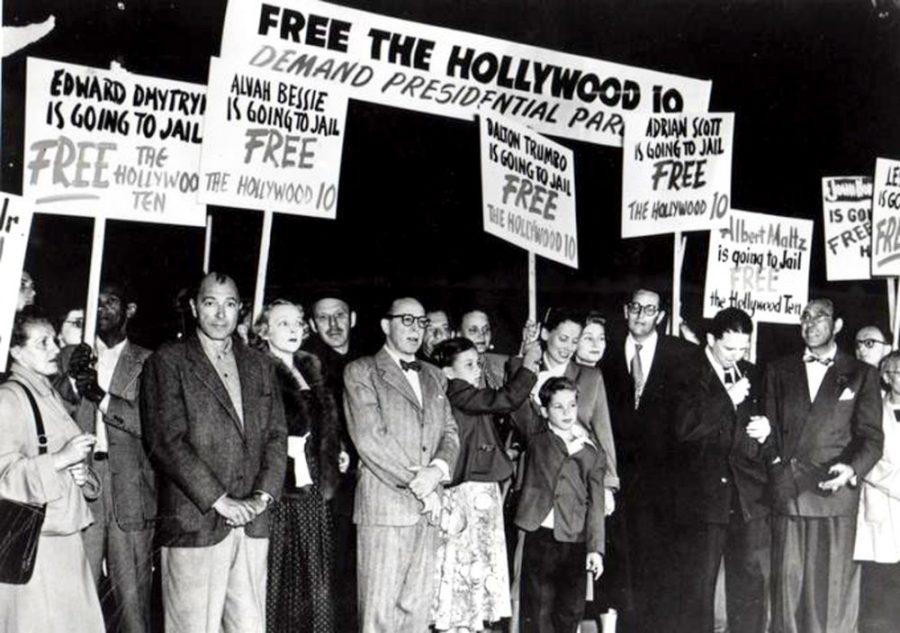Bessie, Biberman, Cole, Dmytryk, Lardner, Lawson, Maltz, Ornitz, Scott and Trumbo: Their names may not be recognizable, but 67 years ago today, they became the first of a long list of actors, writers and directors who would be put on Hollywood’s blacklist.
On Nov. 24, 1947, these 10 Hollywood elites were cited for contempt after refusing to answer questions about their involvement with the Communist party from the House of Un-American Activities Committee. Nicknamed the “Hollywood 10,” all of them were found guilty in a federal court and were sentenced to up to a year in prison with a fine of $1,000.
“As soon as we got the subpoenas, we knew it was serious,” said Albert Maltz, a screenwriter who would be blacklisted from working in Hollywood until 1964. “No such thing had happened before.”
Their imprisonment garnered national attention, and shortly after the hearings, nearly 50 Hollywood executives secretly convened at the Waldorf-Astoria Hotel in New York City to strategize on how to handle these Communist infiltrations. They agree to suspend the Hollywood 10 from their contracts without pay and to deny any further employment at their studios.
After serving their prison sentence, some of the Hollywood 10 were able to keep working under alternative names. Dalton Trumbo won an Academy Award under the name Robbie Rich for penning the screenplay to the 1956 film “The Brave One.” Others, such as Adrian Scott and Samuel Ornitz, never worked in Hollywood again, while Lester Cole and Edward Dmytryk moved to England to keep working.
Dmytryk would reappear before HUAC again in 1951 after he served a four and half-month prison sentence in West Virginia. Dmytryk admitted before the committee to being a former Communist and agreed to identify other Hollywood players who were affiliated with the party.
“I was being forced to sacrifice my family and my career in defense of the Communist Party,” Dmytryk said in his 1978 autobiography, “from which I had long been separated.”
There were some in Hollywood who’d never forgive Dmytryk for naming names to the committee. When invited to speak at a Barcelona Film Festival symposium in 1988, other Hollywood officials reportedly refused to participate in the symposium with Dmytryk.
Dmytryk passed away in 1999, and Ring Lardner Jr., the last surviving member of the Hollywood 10, died the following year.
The Red Scare in Hollywood began shortly after World War II, when the leftist Communist movement gained greater momentum in the film industry. Remnants of the Great Depression disenfranchised many Americans from democratic ideals, and so many turned to Communism, according to historian Geoffrey Stone.
In 1946, J. Edgar Hoover, the director of the FBI, instilled public fear by addressing Communism as a “growing menace”. Former President Harry Truman responded with an executive order to allow the FBI to investigate the loyalty of over four million federal employees.
When J. Parnell Thomas became chairman of the HUAC in 1947, he began snooping into Hollywood after receiving tips of Communist behavior from industry mavericks such as Jack Warner.
In October 1947, Thomas began collecting the testimony of so-called “friendly” witnesses such as Walt Disney, Gary Cooper and Ronald Reagan, who confirmed a Communist presence existing in Hollywood.
The committee then called for the testimony of 19 “unfriendly” witnesses who were under suspicion for Communist affiliation. Ten of these witnesses outright refused to answer personal questions about their political beliefs, which resulted in them being cited for contempt under Congress.
“This committee has encouraged an assortment of well-rehearsed witnesses to testify that I and others are subversive and un-American,” Maltz said during his testimony for HUAC.
According to José Anderson, a professor at the University of Baltimore’s School of Law, citing the Hollywood 10 for contempt introduced a paradox regarding the First and Fifth Amendments of the Constitution: the HUAC was expecting the witnesses to offer self-incriminating evidence against themselves.
Though the appeals issued by the Hollywood 10 were denied by the Supreme Court, Anderson argues this case later influenced theories of constitutional law during the Warren Court era of the mid-1950s.
“The Hollywood 10 … created the national standard for freedom of political association that exists today,” Anderson wrote in 2009.
Though more than 200 people would be blacklisted in Hollywood by the mid-1950s, it is the Hollywood 10 who are remembered as the first victims of this notorious witch-hunt. HUAC remained in existence until being disbanded in 1975.
_______________
Follow Kevin C. Reagan on Twitter.









